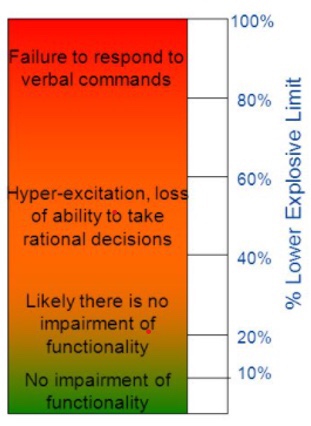The Weekly Reflektion Week 05 / 2021
The potential for fire and explosion from leaking hydrocarbons is well understood and systems are in place to prevent and mitigate these. The narcotic effect of hydrocarbons is perhaps less well understood.
Do you understand the narcotic effect of hydrocarbons and how people may respond to these effects?


The Brent Bravo platform is a concrete platform structure built to a Condeep design and installed in the UK sector of the North Sea. Two of the concrete shafts contain well conductors, are water filled to sea level and are not normally accessed. The third shaft, the utility shaft, contains pipework and pumps for the oil storage and export system, and pipework from the closed drain system. The water level in this shaft is normally maintained at about 66.5 metres below sea level. On 11thNovember 2002, a leak was found in the closed drain pipework and a pipe patch was installed as a temporary measure. An inspection of the patch carried out 8th September 2003, indicated the patch was leaking. On 11th September 2003 two technicians were given the task to replace the patch. A few minutes after they entered the shaft, hydrocarbon gas was detected by the platform fire and gas system. Eight minutes later a high-level gas alarm was initiated that resulted in an emergency shutdown. Attempts were made to contact the technicians in the utility shaft however there was no response. Four hours later the bodies of the technicians were recovered from the shaft and they were pronounced dead.
The work had not been covered by a permit as required by the Permit to Work system. Entry into the utility shaft was defined as work in confined spaces. The pipe patch was not in accordance with the company standards for this application. The pipework had not been isolated before the work started.
The technicians carried a portable breathing apparatus and a portable gas detector into the shaft and historic readings of the hydrocarbon, oxygen and hydrogen sulphide (H2S) content in the atmosphere could be read off for part of the period the technicians were in the utility shaft. The readings showed that there was sufficient oxygen for the initial period and that the H2S level was not significant. The hydrocarbon content increased most likely when the technicians removed the leaking patch. The hydrocarbon content in the atmosphere increased and after about 15 minutes the technicians would have been unable to think for themselves, to use any judgment to protect themselves, or respond appropriately to instructions from the control room. By continuing to inhale volatile hydrocarbons they would have lost consciousness. The oxygen content gradually reduced as the hydrocarbon displaced the air. A measurement of 17.9% was noted before the gas detector battery went dead. It was not possible to say with any certainty the precise mechanism which led from unconsciousness to death.
Do you ensure that people working in areas with a potential for hydrocarbon leaks are aware of the all the hazards from hydrocarbons? Specially do you ensure people are aware of the danger of being overcome by the narcotic effect of hydrocarbons at relatively low concentrations?
Reflekt will be organising a Lunch and Learn on 18th February. The theme for the lunch and learn will be resilience and it will be held on Teams. Check out our web site www.reflekt.as and let us know if you would like to participate. Link to seminaret https://reflekt.as/events/
